Brake system
In physical terms we can state that energy is the capacity of a physical system to do work. When a car comes down a straight line at 300 km/h or more, it possesses lots of kinetic (movement) energy. Due to the fact that energy does not get lost, but can instead only be converted one form into another, the only way to slow down the car is to convert the kinetic energy into another form. Brakes as we know them both in race cars and road cars convert this movement energy to heat.
Formula One cars must sometimes decelerate in a matter of seconds from 350 km/h to about 70 km/h. During such heavy braking, the temperature of the brake rotor and pads can warm up from 400°C to more than 1000°C. These 1000°C occurs at the very end of the braking, and is approximately the highest temperature a carbon brake disc (as they are used in F1, and limited to 28mm thickness and 278mm diameter by the FIA) can take.
Applying carbon brakes
A mere 4 seconds is the amount of time it takes for a Formula One car to go from 300 km/h to a complete halt. At 200 km/h, a Formula One contender requires just 2.9 seconds to stop completely, a process that will have been accomplished over 65 m. At 100 km/h, these values are just as mind-blowing 1.4 seconds and 17 meters! Under these heavy braking periods, a driver is subjected to a horizontal deceleration of close to 5.4G.
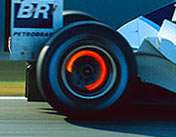 The only configuration that allows this performance at the moment is a brake disc/calliper combination of carbon fibre. Its crude performance creates fast decelerations while its low density keeps the weight per disc below 1 kg. Furthermore, its capacity to take on and dissipate heat provides unequalled longevity: even when heated to over 1000°C prior to cornering, about 800 times per race, the carbon-fibre will last for the duration of a Grand Prix event without complaint. Steel on steel brakes, used until the 80's, were abandoned without any regrets and the overall performance in F1 came out on top.
The only configuration that allows this performance at the moment is a brake disc/calliper combination of carbon fibre. Its crude performance creates fast decelerations while its low density keeps the weight per disc below 1 kg. Furthermore, its capacity to take on and dissipate heat provides unequalled longevity: even when heated to over 1000°C prior to cornering, about 800 times per race, the carbon-fibre will last for the duration of a Grand Prix event without complaint. Steel on steel brakes, used until the 80's, were abandoned without any regrets and the overall performance in F1 came out on top.
Although the braking performance is unrivalled, the use of carbon-fibre brakes requires a little time to get used to for a driver. Jarno Trulli explained: "In fact, during the first milliseconds after pressing the brake-pedal; it feels like nothing is happening. This delay is in fact the length of time required by the disk/calliper tandem to reach operating temperature, which increases by 100°C per tenth of a second for the first half-second of braking, after which it can reach up to 1200°C. After that short period, deceleration is immediate, and brutal". When at optimum operation temperature, the coefficient of friction between the pads and the discs can reach as much as 0.6.
From within their cockpits, drivers can adjust the distribution of braking power between the front and rear of their contenders.This influences the handling of the car. Generally speaking, the front has a priority to within a 51% to 60% margin, depending on track conditions. During a race, reducing the rear braking power allows for reduced rear tyre-wear and thus indirectly influences the traction.
General construction
As with every disc brake system used in road cars, the central part of the system is the brake disc, rotating at the same speed of the wheel. The brake pad with brake blocks are located aside and around the brake disc. When the driver pushes the brake pedal, brake fluid is pushed into the calliper's cylinders and the carbon brake disc is squeezed between the carbon brake blocks. The resulting friction causes the disc and wheel to slow down while producing heat.
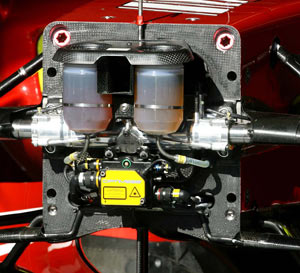 The brake fluid itself is stored in two brake master cylinders, contained in the nose cone and packaged in between the suspension components for space reduction. These master cylinders contain the brake fluid for both the front and rear brakes. The front and rear systems are always connected separately as required by the technical regulations. Such design allows that either the front or the rear wheels can still slow down the car when one of the circuits would fail.
The brake fluid itself is stored in two brake master cylinders, contained in the nose cone and packaged in between the suspension components for space reduction. These master cylinders contain the brake fluid for both the front and rear brakes. The front and rear systems are always connected separately as required by the technical regulations. Such design allows that either the front or the rear wheels can still slow down the car when one of the circuits would fail.
The image on the right shows the master cylinders in a Ferrari F2008 nose cone. Also visible is the steering rack and the plumbing for the power steering system.
Despite the fairly simple system (mostly because the regulations do not allow many other variations), the carbon fibre elements make the brakes a highly expensive part of a Formula One car. Both the pads and the discs are manufactures from the best carbon fibre available (long chain carbon, as in carbon fibre). In fact it can take up to 5 months to produce a single brake disk. The first stage in making a disc is to heat white polyacrylo-nitrile (PAN) fibres until they turn black. This makes them pre-oxidised, and are arranged in layers similar to felt. They are then cut into shape and carbonised to obtain very pure carbon fibres. Next, they undergo two densification heat cycles at around 1000°C. These stages last hundreds of hours, during which a hydrocarbon-rich gas in injected into the oven or furnace. This helps the layers of felt-like material to fuse together and form a solid material. The finished disc is then machined to size ready to install onto the car.
Currently, brake pads and discs are provided by a limited number of manufacturers, including Brembo, Hitco and Carbon Industries. Teams choose their own manufacturer, but sometimes there is a difference between each driver's car. At McLaren in 2007 for example, Fernando Alonso used Hitco brakes while Lewis Hamilton ran with Carbon Industries materials. The callipers themselves are provided by Brembo, AP Racing or Alcon.
Cooling system
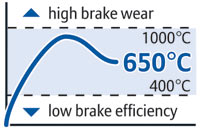 Even though carbon fibre can withstand high temperatures, cooling is vital to ensure that the brakes continue to work effectively all through the last laps of a race. As such, air ducts are created on the inside of the wheel to provide a constant airflow onto the brake system. Today, the cooling systems are ever more complicated and diverse among different teams, but all have in common the perforation of the brake discs.
Even though carbon fibre can withstand high temperatures, cooling is vital to ensure that the brakes continue to work effectively all through the last laps of a race. As such, air ducts are created on the inside of the wheel to provide a constant airflow onto the brake system. Today, the cooling systems are ever more complicated and diverse among different teams, but all have in common the perforation of the brake discs.
Some, if not most of today's teams design their brake ducts (below image, 3) in two separate parts. One, the smallest inlet provides cooling air onto the calliper (below image, 2). The second and larger one then directs an airstream towards the centre of the disc. From there, the air molecules will flow through the brake disc's cooling perforations (below image, 2) to the outside of the disc from where it can flow through the wheel spokes and exit the wheel. The Toro Rosso STR3 even has a carbon fibre shield all around the brake disc and upright to shield off the heat from the brakes from the surrounding wheel rim (below image, right). Also note that the brake calliper on the STR3 is positioned lower than on the Toyota, giving it an advantage as it lowers the centre of gravity of the car's unsprung mass.
In order to further ease this cooling process, Ferrari introduced in 2001 passive cooling fans that rotate around the wheel's axis and at its same speed. It is in a way some kind of a gas turbo for the cooling of the brakes, powered by the rotating wheel. At high speeds, the fan is effectively sucking air into into the system, thereby greatly improving cooling capacity and allowing for the brake duct to be smaller that without a fan. The result is a considerable reduction of ram drag causes by the brake duct.
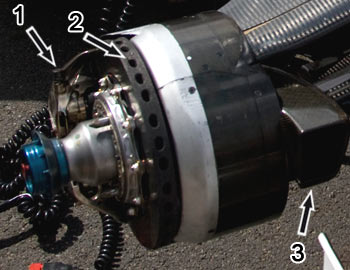 |
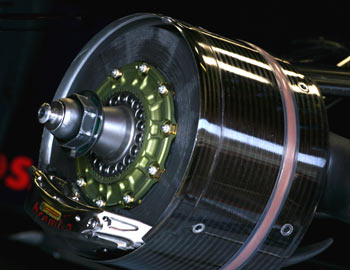 |
Then, in 2007 at Silverstone, Ferrari introduced the static wheel fairing. While this device is more beneficial to airflow around the wheels, it is deemed to be a brake cooling aid by the FIA. Such fairing is a lightweight carbon fibre panel which covers the wheel up without rotating with the wheel itself. The team was therefore able to create an efficient air exhaust where it is most interesting for cooling and for handling it aerodynamically in the car's design. Various teams copied the system during the 2008 season.
New materials
Recently, some teams, including Red Bull have started using rapid prototyping materials for the construction of brake ducts. More specifically, they make use of CRP's Windform XT to speed up the production of parts that are constantly developed. In fact, RP materials do not require a mould to be produced, contrary to carbon fibre elements. Parts can be produced as quickly as in hours, or a few days, instead of weeks that are required for a carbon element. On the other side, if you need a production, the price of the mould (for Carbon lamination) is shared upon several parts and at the end the total price for many parts can be lower. The break even point depends on many different parameters: delivery time, complexity of the shape, performance, quick change/improvement of the design…
Windform is a PA based and Carbon Fibres filled material. The performance is higher than every other RP material, but of course is lower than Carbon laminated parts. Depending on loads and temperatures, it can suit also structural applications, as any other plastic or metal alloys The XT variant is black and has a melting point of 175°C. Therefore it is not applicable for anything close to the heat of the brake discs.
Regulations
11.1.1 All cars must be equipped with only one brake system. This system must comprise solely of two separate hydraulic circuits operated by one pedal, one circuit operating on the two front wheels and the other on the two rear wheels. This system must be designed so that if a failure occurs in one circuit the pedal will still operate the brakes in the other.
11.1.2 The brake system must be designed in order that the force exerted on the brake pads within each circuit are the same at all times.
11.1.3 Any powered device which is capable of altering the configuration or affecting the performance of any part of the brake system is forbidden.
11.1.4 Any change to, or modulation of, the brake system whilst the car is moving must be made by the drivers direct physical input, may not be pre-set and must be under his complete control at all times.
11.2.1 All brake callipers must be made from aluminium materials with a modulus of elasticity no greater than 80Gpa.
11.2.2 No more than two attachments may be used to secure each brake calliper to the car.
11.2.3 No more than one calliper, with a maximum of six pistons, is permitted on each wheel.
11.2.4 The section of each calliper piston must be circular.
11.3.1 No more than one brake disc is permitted on each wheel.
11.3.2 No brake disc may be more than 28mm thick with maximum and minimum diameters of 305mm and 300mm respectively.
11.3.3 No more than two brake pads are permitted on each wheel.
11.4 Air ducts : Air ducts around the front and rear brakes will be considered part of the braking system and shall not protrude beyond :
- a plane parallel to the ground situated at a distance of 160mm above the horizontal centre line of the wheel ;
- a plane parallel to the ground situated at a distance of 160mm below the horizontal centre line of the wheel ;
- a vertical plane parallel to the inner face of the wheel rim and displaced from it by 120mm toward the centre line of the car.
Furthermore, when viewed from the side the ducts must not protrude forwards beyond the periphery of the tyre or backwards beyond the wheel rim.
All measurements will be made with the wheel held in a vertical position.
11.5 Brake pressure modulation :11.5.1 No braking system may be designed to prevent wheels from locking when the driver applies pressure to the brake pedal.
11.5.2 No braking system may be designed to increase the pressure in the brake calipers above that achievable by the driver applying pressure to the pedal under static conditions.
11.6 Liquid cooling :
Liquid cooling of the brakes is forbidden.
